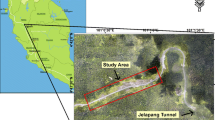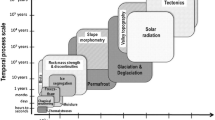Abstract
Rockfall hazard is a main threat for mountainous and hilly areas that can cause loss of life, damage to infrastructures, and traffic interruption. Rockfall frequency and magnitude vary both spatially and temporally; therefore, multi-scenarios related to rockfall characteristics (trajectories, frequency and kinetic energy) can provide early warnings by identifying the areas at risk for mitigation purposes. The aim of this study is to predict the areas at risk from future rockfall incidents and suggest suitable mitigation measures to prevent them. The most significant elements in rockfall analysis are slope topography interpretation or the digital elevation model (DEM) and the rockfall modeling approach. Light detection and ranging (LiDAR) techniques have been widely used in rockfall studies because of their capability to provide high-resolution information regarding slope surfaces. In the current study, airborne laser scanning (ALS) is used to obtain a high-density point cloud (4 pts./m2) of the study area for the construction of an accurate DEM via a geographic information system. Rockfall source areas were identified based on multi-criteria method including DEM derivatives (e.g., slope, aspect, curvature and topographic contrast) in addition to terrain type and aerial photos. A 3D rockfall model has been established to determine rockfall multi-scenarios based on their characteristics according to a range of restitution coefficient (normal and tangential) and friction angle values; these parameters are particularly crucial in rockfall simulation to delineate the spatial prediction of rockfall hazard areas along the Jelapang corridor of the North–South Expressway in Malaysia. In addition, a barrier location was suggested based on limited rockfall height and kinetic energy to mitigate rockfall hazards. Results show that rockfall trajectories (stop** distance) and, subsequently, their frequency and energy are increased; moreover, barrier efficiency is reduced when the values of the mechanical parameters (Rn, Rt, and friction angle) are increased. Nonetheless, the suggested barrier location is an efficient and mitigative measure to eliminate the rockfall effect.


Adopted from Lan et al. (2007)

Adopted from Lan et al. (2007)







Similar content being viewed by others
References
Abd-Allah AM, El-Sawy E, Seif ESA, El-Fakharani A, Sharaf MAM (2014) Rock slope stability and design in Arafat–Muzdalifa area Saudi Arabia. Arab J Geosci 7(10):4029–4042
Ahmad M, Umrao RK, Ansari MK, Singh R, Singh TN (2013) Assessment of rockfall hazard along the road cut slopes of State Highway-72. Geomaterials 3(1):15–23
Akin M, Topal T, Akin MK (2013) Evaluation of the rockfall potential of Kastamonu Castle using 3-D analysis. In: Margottini C, Canuti P, Sassa K (eds) Landslide science and practice. Springer, Berlin, pp 335–340
Ansari M, Ahmad M, Singh T (2014) Rockfall hazard analysis of Ellora Cave, Aurangabad, Maharashtra, India. Int J Sci Res 3(5):427–431
Assali P, Grussenmeyer P, Villemin T, Pollet N, Viguier F (2014) Surveying and modeling of rock discontinuities by terrestrial laser scanning and photogrammetry: semi-automatic approaches for linear outcrop inspection. J Struct Geol 66:102–114
Asteriou P, Saroglou H, Tsiambaos G (2012) Geotechnical and kinematic parameters affecting the coefficients of restitution for rock fall analysis. Int J Rock Mech Min 54:103–113
Bater CW, Coops NC (2009) Evaluating error associated with lidar-derived DEM interpolation. Comput Geosci 35(2):289–300
Blahut J, Klimeš J, Vařilová Z (2013) Quantitative rockfall hazard and risk analysis in selected municipalities of the České Švýcarsko National Park, Northwestern Czechia. Geografie 118(3):205–220
Čarman M, Bavec M, Komac M, Krivic M (2015) Rockfall susceptibility assessment at the municipal scale (Bovec municipality, Slovenia). In: Lollino G, Giordan D, Crosta GB, Corominas J, Azzam R, Wasowski J, Sciarra N (eds) Engineering geology for society and territory, vol 2. Springer, Berlin, pp 2017–2021
Chai B, Tang Z, Zhang A, Du J, Su H, Yi H (2015) An uncertainty method for probabilistic analysis of buildings impacted by rockfall in a limestone quarry in Fengshan, Southwestern China. Rock Mech Rock Eng 48(5):1981–1996
Chen G, Zheng L, Zhang Y, Wu J (2013) Numerical simulation in rockfall analysis: a close comparison of 2-D and 3-D DDA. Rock Mech Rock Eng 46(3):527–541
Chiessi V, D’Orefice M, Mugnozza GS, Vitale V, Cannese C (2010) Geological, geomechanical and geostatistical assessment of rockfall hazard in San Quirico Village (Abruzzo, Italy). Geomorphology 119(3):147–161
Fanos AM, Pradhan B (2016) Multi-scenario Rockfall Hazard Assessment Using LiDAR Data and GIS. Geotech Geol Eng. doi:10.1007/s10706-016-0049-z
Ferrari F, Giani GP, Apuani T (2013) Why can rockfall normal restitution coefficient be higher than one. Rendiconti online della Società Geologica Italiana 24:122–124
Filipello A, Mandrone G, Bornaz L (2015) Structural data treatment to define rockfall susceptibility using long range laser scanner. Eng Geol Soc Territory 6:721–724
Firpo G, Salvini R, Francioni M, Ranjith P (2011) Use of digital terrestrial photogrammetry in rocky slope stability analysis by distinct elements numerical methods. Int J Rock Mech Sci Min 48(7):1045–1054
Flentje P, Palamakumbure D, Thompson J (2015) Assessing rockfall along the Illawarra escarpment. Eng Geol Soc Territory 2:2031–2036
Frattini P, Crosta GB, Agliardi F, Imposimato S (2013) Challenging calibration in 3D rockfall modelling. In: Margottini C, Canuti P, Sassa K (eds) Landslide science and practice. Springer, pp 169–175
Gallay M (2013) Direct acquisition of data: airborne laser scanning. Geomorphol Tech 1–17. British Society for Geomorphology
Gallay M, Lloyd CD, McKinley J, Barry L (2013) Assessing modern ground survey methods and airborne laser scanning for digital terrain modelling: a case study from the Lake District, England. Comput Geosci 51:216–227
Glover J, Bartelt P, Christen M, Gerber W (2015) Rockfall-simulation with irregular rock blocks. In: Lollino G, Giordan D, Crosta GB, Corominas J, Azzam R, Wasowski J, Sciarra N (eds) Engineering geology for society and territory, vol 2. Springer International Publishing, Switzerland, pp 1729–1733
Heckmann T, Schwanghart W (2013) Geomorphic coupling and sediment connectivity in an alpine catchment—Exploring sediment cascades using graph theory. Geomorphology 182:89–103
Kenner R, Bühler Y, Delaloye R, Ginzler C, Phillips M (2014) Monitoring of high alpine mass movements combining laser scanning with digital airborne photogrammetry. Geomorphology 206:492–504
Keskin I (2013) Evaluation of rock falls in an urban area: the case of Bogazici (Erzincan/Turkey). Environ Earth Sci 70:1619–1628
Kharel P, Dhakal S (2013) Hazard rating and event tree analysis for assessing rockfall risks along Siddhartha highway in Siddhababa area Nepal. Int J Landslide Envion 1(1):41–42
Ku C (2012) Assessing rockfall hazards using a three-dimensional numerical model based on high resolution DEM. In: The twenty-second international offshore and polar engineering conference, International Society of Offshore and Polar Engineers
Lambert S, Bourrier F, Toe D (2013) Improving three-dimensional rockfall trajectory simulation codes for assessing the efficiency of protective embankments. Int J Rock Mech Min Sci 60:26–36
Lan H, Martin CD, Lim C (2007) RockFall analyst: a GIS extension for three-dimensional and spatially distributed rockfall hazard modeling. Comput Geosci 33(2):262–279
Lan H, Martin CD, Zhou C, Lim CH (2010) Rockfall hazard analysis using LiDAR and spatial modeling. Geomorphology 118(1):213–223
Lato MJ, Diederichs MS, Hutchinson DJ, Harrap R (2012) Evaluating roadside rockmasses for rockfall hazards using LiDAR data: optimizing data collection and processing protocols. Nat Hazards 60(3):831–864
Leine R, Schweizer A, Christen M, Glover J, Bartelt P, Gerber W (2014) Simulation of rockfall trajectories with consideration of rock shape. Multibody Syst Dyn 32(2):241–271
Li L, Lan H (2015) Probabilistic modeling of rockfall trajectories: a review. B Eng Geol Environ 74(4):1163–1176
Macciotta R, Martin CD, Cruden DM (2014) Probabilistic estimation of rockfall height and kinetic energy based on a three-dimensional trajectory model and Monte Carlo simulation. Landslides 12(4):757–772
Meng X, Currit N, Zhao K (2010) Ground filtering algorithms for airborne LiDAR data: a review of critical issues. Remote Sens 2(3):833–860
Mikoš M, Petje U, Ribičič M (2006) “Application of a rockfall simulation program in an alpine valley in Slovenia”. In Proceedings of the INTERPRAEVENT, international symposium disaster mitigation of debris flows, Slope Failures and Landslides, Niigata, 25–27 September, p 199
Papathanassiou G, Marinos V, Vogiatzis D, Valkaniotis S (2013) A rock fall analysis study in Parnassos area, Central Greece in Landslide Science and Practice. Springer, Berlin, pp 67–72
Rammer W, Brauner M, Dorren L, Berger F, Lexer M (2010) Evaluation of a 3-D rockfall module within a forest patch model. Nat Hazards Earth Syst Sci 10(4):699–711
Sabatakakis N, Depountis N, Vagenas N (2015) Evaluation of rockfall restitution coefficients. In: Lollino G, Giordan D, Crosta GB, Corominas J, Azzam R, Wasowski J, Sciarra N (eds) Engineering geology for society and territory, vol 2. pp 2023–2026
Samodra G, Chen G, Sartohadi J, Hadmoko D, Kasama K (2014) Automated landform classification in a rockfall-prone area, Gunung Kelir Java. Earth Surf Dyn 2(1):339–348
Singh P, Wasnik A, Kainthola A, Sazid M, Singh T (2013) The stability of road cut cliff face along SH-121: a case study. Nat Hazards 68(2):497–507
Topal T, Akin M, Ozden UA (2007) Assessment of rockfall hazard around Afyon Castle Turkey. Environ Geol 53(1):191–200
Wang X, Frattini P, Crosta G, Zhang L, Agliardi F, Lari S, Yang Z (2014) Uncertainty assessment in quantitative rockfall risk assessment. Landslides 11(4):711–722
Wise S (2011) Cross-validation as a means of investigating DEM interpolation error. Comput Geosci 37(8):978–991
Wyllie DC (2014). Rock Fall Engineering. CRC Press, pp. 270
Youssef AM, Pradhan B, Al-Kathery M, Bathrellos GD, Skilodimou HD (2015) Assessment of rockfall hazard at Al-Noor Mountain, Makkah city (Saudi Arabia) using spatio-temporal remote sensing data and field investigation. J Afr Earth Sci 101:309–321
Yusof NM, Pradhan B, Shafri HZM, Jebur MN, Yusoff Z (2015) Spatial landslide hazard assessment along the Jelapang Corridor of the North–South Expressway in Malaysia using high resolution airborne LiDAR data. Arab J Geosci 8(11):9789–9800
Acknowledgments
Authors would like to two anonymous reviewers and Editorial comments of Prof. Dr. Olaf Kolditz for their valuable comments on the earlier version which helped us to improve the manuscript.
Author information
Authors and Affiliations
Corresponding author
Rights and permissions
About this article
Cite this article
Fanos, A.M., Pradhan, B., Aziz, A.A. et al. Assessment of multi-scenario rockfall hazard based on mechanical parameters using high-resolution airborne laser scanning data and GIS in a tropical area. Environ Earth Sci 75, 1129 (2016). https://doi.org/10.1007/s12665-016-5936-3
Received:
Accepted:
Published:
DOI: https://doi.org/10.1007/s12665-016-5936-3




